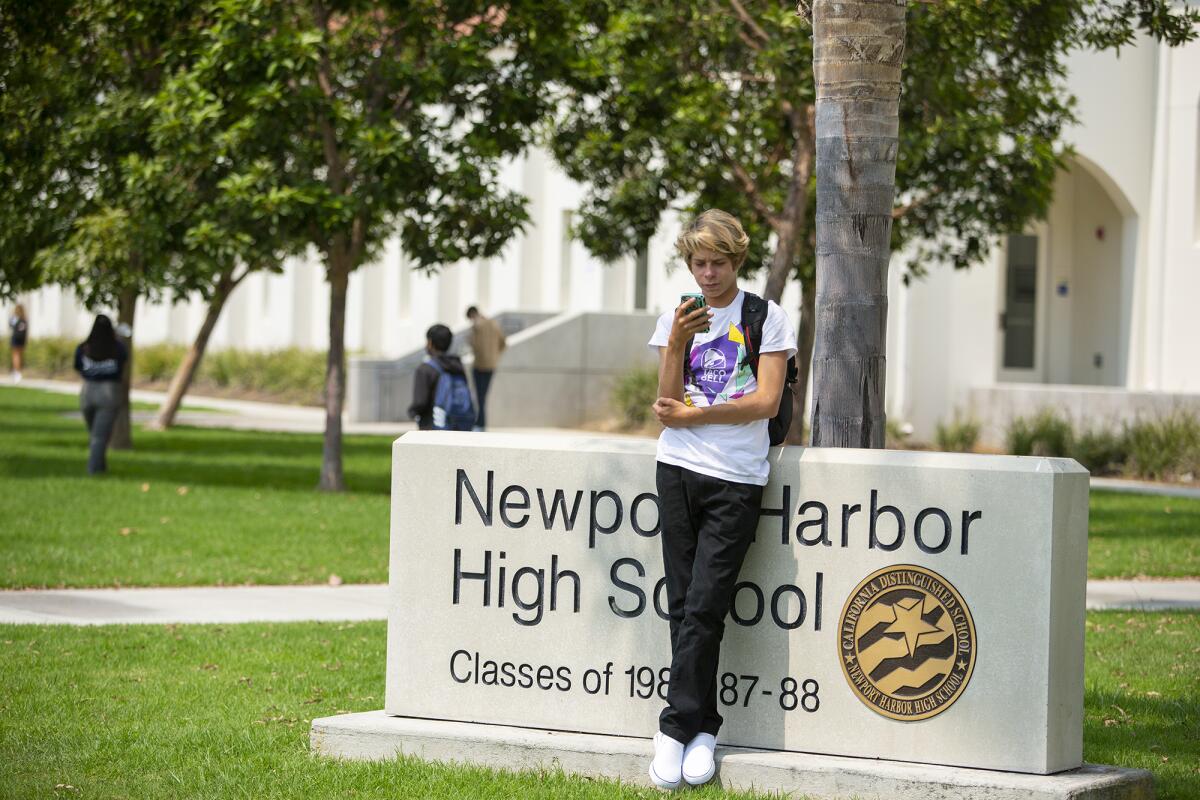Apodaca: Newport-Mesa Unified moves to disconnect cellphone use

- Share via
A funny thing happened on the way to implementing Newport-Mesa Unified School District’s more restrictive cellphone policy. Almost no one objected.
They had anticipated some pushback. I would have expected a lot of pushback.
After all, when the district’s board approved the new policy last fall, it was moving into territory where most districts hadn’t ventured as yet. So, in a sense, Newport-Mesa was flying a bit blind when it came to how best to make the new policy work and in terms of how it would be received.
Not that there hasn’t been widespread agreement that cellphones have created a lot of headaches for K-12 education. Pretty much everyone acknowledges the problems that stem from students who are glued to their phones, distracted by constant messages and connected to social media while they are meant to be paying attention to lessons.
What’s more, cellphones are often the vehicles by which bullying and harassment of some students continue throughout class time. Hard for students to concentrate on congruent triangles when they’re traumatized.
And spare some compassion for teachers, who are at their wits’ ends trying to get kids to engage.
To be clear, most schools do have longstanding cellphone policies. They typically call for phones to be stashed away during class. There are exceptions, such as when teachers authorize their use for lessons or in case of emergencies. But for the most part these policies have no teeth — they are notoriously difficult to enforce and easily ignored.
That’s why districts across the nation have been grappling with the question of whether, and how, to crack down on cellphone use. At this point, most are still in the talking stages regarding next steps.
There is increasing movement of late.
In June, the Los Angeles Unified School District, the second largest in the nation, spawned a rash of headlines when it decided to ban cellphone use all day on campuses. And some states — including California — are proposing to adopt statewide restrictions on cellphone use at public schools.
Such policies are not without controversy. Some of the objections come from students, as one might expect. But some parents also criticize cellphone bans, arguing that the devices are important for security and necessary communication. Even a few teachers have complained about adding the policing of classroom bans to their already-daunting workloads.
While all this nationwide drama and discussion has been playing out, Newport-Mesa has been quietly implementing its new policy over the past several months.
Loneliness is a hidden epidemic with real health consequences increasingly recognized by public health officials.
“Over the last couple of years we have observed students at all levels, but mostly secondary schools, who have been exceptionally distracted from instruction because of cellphones,” said Newport-Mesa’s Assistant Supt. of Secondary Education Kerrie Torres.
“Inside the classrooms students are redirected to put their phones away. The problem is kids are unable to. It’s a habitual act. Ten minutes later phones are back out.”
So a couple of years ago the district began looking into ways to rewrite its cellphone policy. District officials studiously avoid using the word “ban” — but, as Torres said, they wanted to craft a policy that was more “restrictive and supportive.” The effort included talking to parents, students and teachers, and researching the experiences of a few school districts in other states that were further ahead on implementation.
The new policy delivers important changes. Students in preschool through eighth grade are not allowed to use cellphones on campus. If they bring phones to school, the devices must be turned off and put away. If they need to make a call, they are instructed to use a school office phone.
High school students are required to turn off their phones during instructional time, with certain specific exceptions, including when a teacher gives permission, during an emergency or because of a cleared medical or educational need.
It has gone surprisingly well so far.
Torres received no complaints about the new cellphone restrictions, just questions, such as whether students could still wear smart watches. (The answer: yes.)
The district also adopted a flexible approach to implementation, allowing individual school sites to experiment with different ways to make the new policy work more smoothly. One school, for instance, has been using numbered cellphone caddies — not unlike shoe pocket organizers — that students can use to store their phones while in class. Another school will be trying out concert-style cellphone pouches in the coming school year.
So far, Torres has received mostly positive feedback from teachers and parents. And the number of disciplinary referrals for inappropriate online posting during the school day declined after the new policy took effect.
But she said the intent is to continually analyze the impact on students — whether the restrictions might compromise anyone’s safety, for instance — and make adjustments as needed.
“We’re trying to be a really data-driven organization,” she said. “We might have to pivot. But we’re open to that.”
That’s a common-sense approach.
No policy will completely fix what has become a huge impediment to learning. But if everyone keeps an open mind as more feedback becomes available and as tweaks are made, this one could make a positive difference. Hopefully at some point, unplugging at school might just be a normal part of the daily routine.
All the latest on Orange County from Orange County.
Get our free TimesOC newsletter.
You may occasionally receive promotional content from the Daily Pilot.







